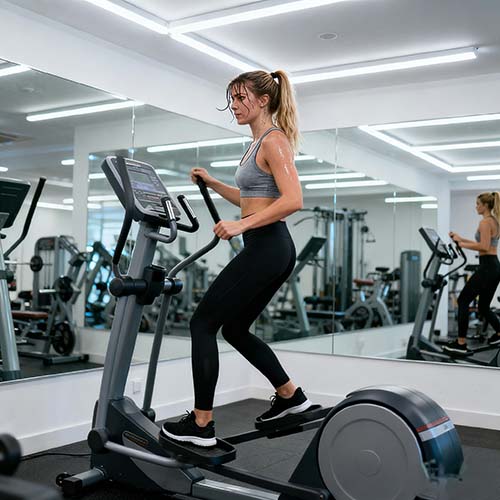In the concept of modern healthy living, aerobic exercise is undoubtedly one of the core forms of exercise that has received much attention. It is not only an important choice for ordinary people to maintain health but also a key means for fitness enthusiasts to improve physical fitness and shape their bodies. So, what exactly is aerobic exercise? What positive effects can it bring to our bodies, and how should we carry out aerobic exercise scientifically?
First, let's clarify the definition of aerobic exercise. Simply put, aerobic exercise refers to physical exercise carried out by the human body in a state of sufficient oxygen supply. During the exercise, the body's oxygen consumption will increase, and the heart rate and breathing will also speed up accordingly, but it can always maintain a relatively stable rhythm, so that oxygen can be continuously and effectively transported to various tissues and organs of the body to provide energy for the exercise.

Common forms of aerobic exercise are rich and diverse, which can meet the preferences and exercise scene needs of different people. For example, jogging leisurely in the park or on the street, feeling the breeze on your face while allowing your body to gradually enter the exercise state; swimming in the pool, stretching your limbs, the buoyancy of the water can not only reduce joint pressure but also allow the whole body muscles to be fully exercised; and the familiar cycling, whether it is cycling outdoors to enjoy the scenery along the way or riding a spinning bike indoors following the rhythm, both belong to typical aerobic exercises. In addition, exercises such as skipping rope, brisk walking, aerobics, and playing badminton can also be classified as aerobic exercises as long as the exercise intensity and duration reach a certain standard.
Adhering to aerobic exercise has many significant benefits for physical health. From the perspective of the cardiovascular system, regular aerobic exercise can STRENGTHen the heart muscle and improve the heart's pumping function. In the long run, the amount of blood pumped out by the heart with each beat will increase, and the heart rate will gradually decrease, which means that the heart works more easily and efficiently in daily life, thus effectively reducing the risk of cardiovascular diseases such as hypertension and coronary heart disease.
For the respiratory system, aerobic exercise can improve the lung ventilation function and increase the vital capacity. When exercising, our breathing will deepen and speed up, which will make the alveoli in the lungs more fully expanded and contracted, improving the gas exchange efficiency, allowing the body to better obtain oxygen in normal times and relieving fatigue.
In terms of metabolism and weight management, aerobic exercise also plays an important role. During the exercise, the body will consume a large amount of energy, and this energy mainly comes from the decomposition of fat and carbohydrates. Long - term adherence to aerobic exercise can increase the body's basal metabolic rate, so that even when resting, the body can consume more calories, which helps to reduce fat accumulation in the body, maintain a healthy weight, and shape a 匀称 figure. At the same time, aerobic exercise can also promote blood circulation in the body, providing sufficient nutrients and oxygen for various organs and tissues of the body, helping to improve physiological functions and enhance immunity, making us more energetic to cope with daily life and work.
However, if you want to make aerobic exercise truly play the best role, you also need to master scientific methods. The first is the choice of exercise intensity. For beginners, it is not advisable to choose too high an intensity at the beginning. You can start from a low intensity to give the body an adaptation process, and then gradually increase the intensity according to your own situation. To judge whether the exercise intensity is appropriate, you can judge by feeling your own breathing and heart rate. Generally speaking, when exercising, you can speak normally but not sing easily, and the heart rate is maintained between 60% and 80% of the maximum heart rate (the maximum heart rate is usually estimated as 220 minus the age), which is a more appropriate intensity.
Secondly, it is the exercise duration and frequency. It is generally recommended to carry out aerobic exercise 3 to 5 times a week, and each exercise time should be kept between 30 and 60 minutes. Of course, this is only a reference standard, and the specific time needs to be adjusted according to personal physical conditions, exercise goals, and time arrangements. If time is tight, each exercise can also be split into 2 to 3 short time periods, for example, 15 to 20 minutes each time. As long as the total duration meets the standard, a good exercise effect can also be achieved.
In addition, the warm - up and stretching links before and after aerobic exercise are essential. Warm - up exercises before exercise, such as brisk walking and joint rotation, can gradually increase the body temperature, relax the muscles, and move the joints, effectively reducing the probability of sports injuries; the stretching exercises after exercise can help relieve muscle tension, promote muscle recovery, reduce muscle soreness, and at the same time, it can also improve the body's flexibility.

At the same time, during the exercise, you should pay attention to timely replenishment of water to avoid dehydration; choose suitable sports equipment, such as comfortable sports shoes and breathable sportswear, etc., which can make us more comfortable and safe during the exercise.
In short, aerobic exercise is a simple and easy - to - do exercise method with many benefits. Whether it is to improve physical health, manage weight, relieve stress, or improve the quality of life, adhering to scientific aerobic exercise can bring us unexpected gains. Let's take active action to integrate aerobic exercise into our daily lives and light up a healthy life with exercise.


 Rizhao Unique Fitness Co.,Ltd
Rizhao Unique Fitness Co.,Ltd